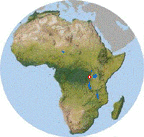|
- Ashford, R. W., Reid, G. D. F. & Butynski, T. M. (1990). The intestinal faunas of man and mountain gorillas in a shared habitat. Ann. Trop. Med. Parasitol. 84: 337-340.
- Byrne, R. W. & Byrne, J. M. E. (1993). Complex leaf-gathering skills of mountain gorillas (Gorilla g. beringei) -- variability and standardization. Am. J. Primatol. 31: 241-261.
- Eberle, R. (1992). Evidence for an alpha-herpesvirus indigenous to mountain gorillas. J. Med. Primatol. 21: 246-251.
- Field, D., Chemnick, L., Robbins, M., Garner, K. & others. (1998). Paternity determination in captive lowland gorillas and orangutans and wild mountain gorillas by microsatellite analysis. Primates. 39: 199-209.
- Fossey, D. (1983). Gorillas in the Mist. Boston: Houghton Mifflin.
- Fossey, D. & Harcourt, A. H. (1977). Feeding ecology of free-ranging mountain gorilla (Gorilla gorilla beringei). pp. 415-447 IN Clutton-Brock, T. H. (Ed.), Primate Ecology. London: Academic Press.
- Foster, J. W. (1992). Mountain gorilla conservation -- a study in human values. J. Am. Vet. Med. Assoc. 200: 629-633.
- Garner, K. J. & Ryder, O. A. (1996). Mitochondrial DNA diversity in gorillas. Molecular Phylogenetics and Evolution. 6: 39-48.
- Harcourt, A. H., Stewart, K. & Hauser, M. (1993). The social use of vocalizations by gorillas: I. Social behavior and vocal repertoire. Behaviour. 124: 89-122.
- Mahaney, W. C., Aufreiter, S. & Hancock, R. G. V. (1995). Mountain gorilla geophagy -- a possible seasonal behavior for dealing with the effects of dietary changes. Int. J. Primatol. 16: 475-488.
- Mahaney, W. C., Watts, D. P. & Hancock, R. G. V. (1990). Geophagia by mountain gorillas (Gorilla gorilla beringei) in the Virunga Mountains, Rwanda. Primates. 31: 113-120.
- Robbins, M. M. (1995). A demographic analysis of male life history and social structure of mountain gorillas. Behaviour. 132: 21-47.
- Robbins, M. M. (1996). Male-male interactions in heterosexual and all-male wild mountain gorilla groups. Ethology. 102: 942-965.
- Robbins, M. M. & Czekala, N. M. (1997). A preliminary investigation of urinary testosterone and cortisol levels in wild male mountain gorillas. Am. J. Primatol. 43: 51-64.
- Schaller, G. B. (1963). The Mountain Gorilla. Chicago: University of Chicago Press.
- Sicotte, P. (1994). Effect of male competition on male-female relationships in bi-male groups of mountain gorillas. Ethology. 97: 47-64.
- Sicotte, P. (1995). Interpositions in conflicts between males in bimale groups of mountain gorillas. Folia primatol. 65: 14-24.
- Stewart, K. J. & Harcourt, A. H. (1987). Gorillas: Variation in female relationships. pp. 155-164 IN Smuts, B. B., Cheney, D. L., Seyfarth, R. M., Struhsaker, T. T. & Wrangham, R. W. (Ed.), Primate Societies. Chicago: University of Chicago Press.
- van Overstraeten, M. & Trefois, P. (1993). Detectability of land systems by classification from LANDSAT Thematic Mapper data -- Virunga National Park (Zaire). Int. J. Remote Sensing. 14: 2857-2873.
- Watts, D. P. (1989). Mountain gorilla life histories, reproductive competition, and sociosexual behavior and some implications for captive husbandry. Zoo Biol. 9: 1-16.
- Watts, D. P. (1991). Strategies of habitat use by mountain gorillas. Folia primatol. 56: 1-16.
- Watts, D. P. (1994). Agonistic relationships between female mountain gorillas (Gorilla gorilla beringei). Beh. Ecol. Sociobiol. 34: 347-358.
- Watts, D. P. (1994). The influence of male mating tactics on habitat use in mountain gorillas (Gorilla gorilla beringei). Primates. 35: 35-47.
- Watts, D. P. (1994). Social relationships of immigrant and resident female mountain gorillas, II: relatedness, residence, and relationships between females. Am. J. Primatol. 32: 13-30.
- Watts, D. P. (1997). Agonistic interventions in wild mountain gorilla groups. Behaviour. 134: 23-57.
- Watts, D. P. (1998). A preliminary study of selective visual attention in female mountain gorillas (Gorilla gorilla beringei). Primates. 39: 71-78.
- Weber, A. W. (1987). Socioecologic factors in the conservation of Afromontane forest reserves. pp. 205-229 IN Marsh, C. W. & Mittermeier, R. A. (Ed.), Primate Conservation in the Tropical Rainforest. New York: Alan R. Liss.
|
 Karisoke Research Centre, Rwanda
Karisoke Research Centre, Rwanda Karisoke Research Centre, Rwanda
Karisoke Research Centre, Rwanda